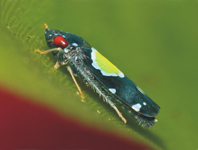Abstract
A new genus, Cavichiana, is described for a new species of Cicadellini, C. bromelicola, from Southeastern Brazil (states of Rio de Janeiro and São Paulo). The new genus can be distinguished from other genera of the Cicadellini by the following combination of features: (1) head deltoid, strongly produced anteriorly; (2) ocelli located distinctly anterad of anterior eye angles; (3) aedeagus tubular, elongate, its apex with a conspicuous crown of spines; (4) paraphyses with both stalk and rami elongate, rami slender and each with basidorsal dentiform projection. The new species has a distinctive color pattern. The dorsum is dark brown to black with contrasting blue to white spots. The anterior half of the fore wings has a large, circular transcommissural yellow macula bordered by a blue to white border, the anterior portion of this macula covering the scutellum. Specimens of the new species were found on leaves of bromeliads in areas of restinga (sand dune vegetation) of the Atlantic Forest of Southeastern Brazil. Other cases of association between hemipterans and bromeliads are listed and briefly discussed.

